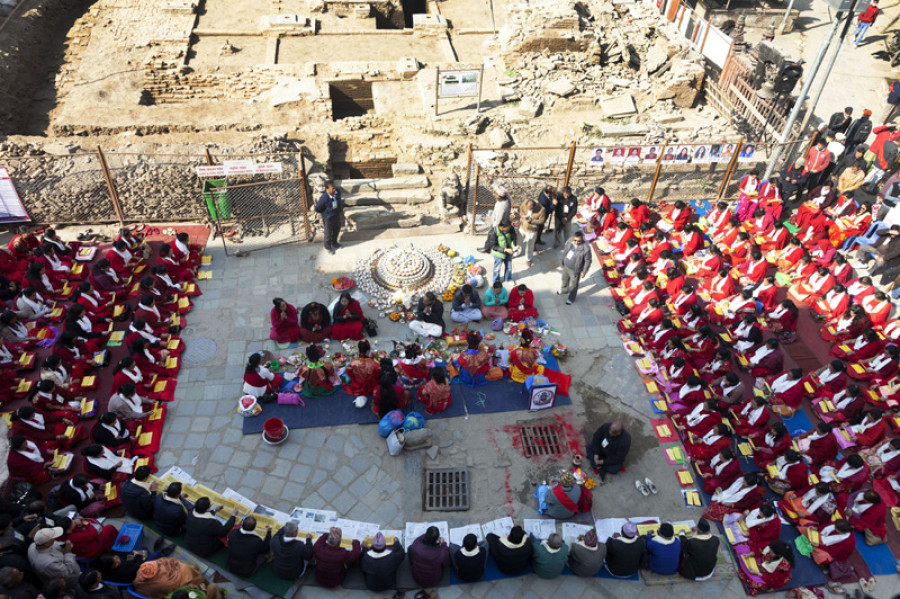Miscellaneous
Year Ender 2016: Build Back Right
With concerns over the lowest-bidder tender system and disregard for traditional building methods, locals remain wary about the haphazard reconstruction of heritage sites in the Valley
Dipesh Khatiwada
Hundreds of heritage sites in the country were reduced to rubble by the devastating earthquakes of April and May 2015. At a time when nearly 9,000 lives were lost and hundreds of thousands of houses were destroyed, it took a while before it became clear that Nepal’s invaluable heritage, many of which are featured on the UNESCO World Heritage List, had suffered untold damage.
In another four months, it will be two years since the disastrous earthquake. So far, the Boudhanath Stupa is the only structure that has been fully restored, and that too through a local-level initiative.
In the heart of the city of Kathmandu lies the iconic Basantapur Durbar Square that houses numerous structures of immense historical, religious and archaeological importance, many of which were damaged by the earthquake to a great extent. The thought of when and how these structures will be reconstructed has lingered on the minds of many for months.
Prakash Shahi, a 40-year-old tourism entrepreneur, who lives in Damai Tol near Hanuman Dhoka, says he is saddened by the lack of interest from the responsible authorities to restore the historical monuments.
The Department of Archaeology (DoA), the government agency that oversees sites of archaeological and historic importance, says renovation of several heritage sites, including Kathmandu, Lalitpur and Bhaktapur Durbar Squares, has started after the initial design and drawing works were drawn up. “It took nearly six to seven months to complete the designs and drawings and to assess the damage. We started reconstruction work at the heritage sites in the middle of the last fiscal year,” said Sampat Ghimire, a senior divisional engineer at the DoA, attributing the delay to the ambiguity over working guidelines.
While local authorities and concerned officials say that the reconstruction of these sites has gradually picked up pace, there are some concerns that remain unaddressed.
The UN culture agency has consistently laid stress on the proper reconstruction of all damaged structures, rather than just quick repair. Christian Manhart, UNESCO’s representative to Nepal, opined his view saying, “It’s better to reconstruct heritage sites slowly and to do it well, than to do it too quickly,” adding that the heritage reconstruction requires extensive research and testing of foundations and materials to determine the best way to rebuild.
What is worrisome is the outcome of a meeting of the UN World Heritage Committee whereby the entire Kathmandu Valley was proposed to be enlisted as the “endangered heritage site” because of the concerns regarding snail-paced efforts towards the protection and reconstruction of the severely damaged monuments and the disregard for traditional building methods.
UNESCO has repeatedly called on local authorities to follow the archaeological, historical and cultural standards upfront while reconstructing the monuments damaged by the quake. It is worth noting that rebuilding of the historic Rani Pokhari temple this year had been halted after UNESCO raised serious concerns about the methods and materials used. “In several meetings, UNESCO representatives have suggested that we complete the reconstruction, but by staying mindful about the methods and materials used,” said Bhesh Narayan Dahal, director general of the DoA.
This despite the fact that the DoA had already invited 48 tenders to reconstruct the historical sites last year paying no heed to local communities’ concern over it. This year, the department has planned to invite 87 more tenders and within the first five months of the current fiscal year, tenders have already been invited for 30 sites. Local communities have been vocally arguing that heritage sites, unlike other building projects, should not be handed over to the lowest bidder, who cut corners during the construction in order to drive down their prices.
The DoA, Kathmandu Metropolitan City Office, UNESCO, the Chinese government, the Indian Embassy, Kathmandu Valley Preservation Trust, Heritage and Environment Conservation Foundation Nepal and other donor organisations are all putting efforts in the renovation of the heritage sites.
The DoA is working at the heritage sites with 78 engineers—30 architects, 23 engineers and 25 sub-engineers. Gopal Jha, a site engineer at Basantapur Durbar Square, said the team of engineers has completed 20 percent of the reconstruction work in the Durbar and Hanuman Dhoka areas. “We have identified woodworks from several temples and have separated them in different clusters,” he said, indicating that rebuilding works will gain momentum in next few months.
More than 1,565 artifacts, including three copper inscriptions, five stone idols, and other carved wooden members such as doors and windows were re-assembled where possible. Pillars (thaam), struts, brackets (meth), joist heads (dhalinkhwas), cornices (jhalar) and icons were also recovered in Hanuman Dhoka Durbar Square. The inventory documentation of objects in the Durbar has been completed now, UNESCO said. In total, 10 structures of Hanuman Dhoka Durbar Square collapsed during the quakes and with other structures seeing significant damage as well.
In Lalitpur, reconstruction of the Patan Durbar Square, Rato Machhindranath and Manakamana temples are underway. “We have completed 75 percent of the drawings and designs of other heritage sites as well,” said engineer Dhurba Adhikari. Mohan Krishna Shrestha, a site engineer at Bhaktapur Durbar Square, said around 10 percent of the reconstruction work has been completed in Bhaktapur so far.
According to the DoA records, a total of 750 historical, cultural and religious monuments in 20 districts were damaged by the April 25 earthquake and its aftershocks. Among them, 133 have been completely destroyed while 617 sustained partial damage.
The Valley’s seven sites which were included in the UN World Heritage List in 1979 for their archaeological, historical, cultural and religious significance had sustained significant damage in the quakes. Among them, Swayambhunath Stupa, Changu Narayan temple, and the three durbar squares suffered considerable damage. Boudhanath Stupa and Pashupatinath Temple were partially damaged as well.
With view of speeding up the rebuilding efforts, the DoA has asked for 900,000 cubic feet of high-quality Saal wood from the government to reconstruct the heritage sites. The Timber Corporation of Nepal is thus going to provide the wood upon the direction of the Ministry of Forest. “We need dry wood, not green ones. It takes more than six months to prepare quality wood to use in traditional construction. The corporation has a huge responsibility to provide readymade wood. The reconstruction works could be affected otherwise,” said Ghimire, adding that it takes two to three years to complete the reconstruction of a temple if the construction materials are easily available. The time frame of reconstruction will increase in according to the shape and size of the heritage sites, according to archaeological officials.
Reconstruction of Dharahara and Ranipokhari
The Government has also drawn up plans to reconstruct Dharahara in roughly 30 ropanies of land, including 6 ropanies for the main structure of Dharahara itself and 23 ropanies for Goswara Hulak and Taksar Department.
The new design for the Dharahara has 2-storey underground basement that can park an estimated 700 vehicles. The proposal for the project has been sent to the cabinet through the Ministry of Culture. If the cabinet gives permission for the design and the budget, it may be about two months before the work begins, officials at the DoA said.
The reconstruction of Ranipokhari has now been delayed after locals protested against the illegal construction of the Balgopaleshwor Temple, which lies at the heart of the Ranipokhari, using steel and concrete.
Though the KMC had taken the responsibility of reconstructing the entire Ranipokhari project, following the public outcry, it has now agreed to let the DoA oversee the construction, but the process is still on hold. The DoA has already prepared the design and drawings of the temple prioritising the reconstruction work of Ranipokhari through traditional building methods.
Along with Ranipokhari, the DoA also hopes to complete the reconstruction of 30 other monuments in the next year. “We have already started working on rebuilding various sites. Within two to three years, the reconstruction of many heritage sites will be completed,” said Bhesh Narayan Dahal, director general of the DoA.
“People can gauge the quality of work being carried out within a span of just a few months. However, we cannot do anything if the MoF delays the budget allocation. We have had to constantly appeal for the budget at the Ministry; and now finally, we have some budget to initiate the task with,” said Dahal.
The DoA has so far been roughly approved for Rs 1 billion by the MoF for heritage site reconstruction. The DoA officials had initially estimated a need of nearly Rs 120 billion for the reconstruction of all heritage sites damaged by the April 2015 earthquake and its aftershocks. The Post Disaster Recovery Framework (PDRF) report, however, has estimated a total need of 34 billion USD to rebuild the affected monuments.




 8.12°C Kathmandu
8.12°C Kathmandu










